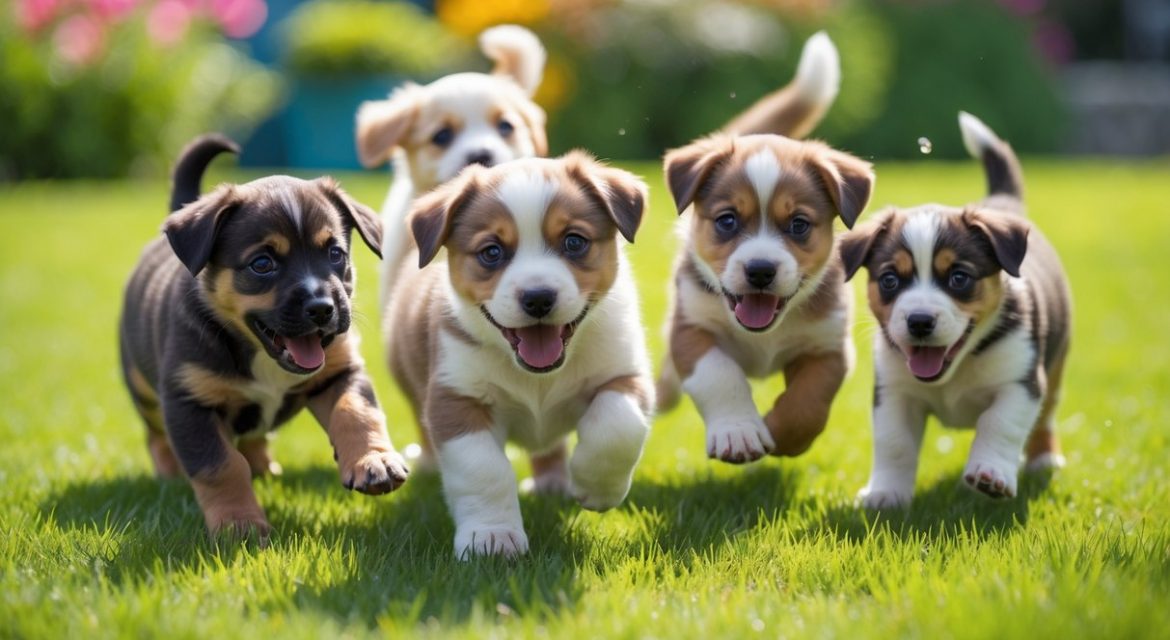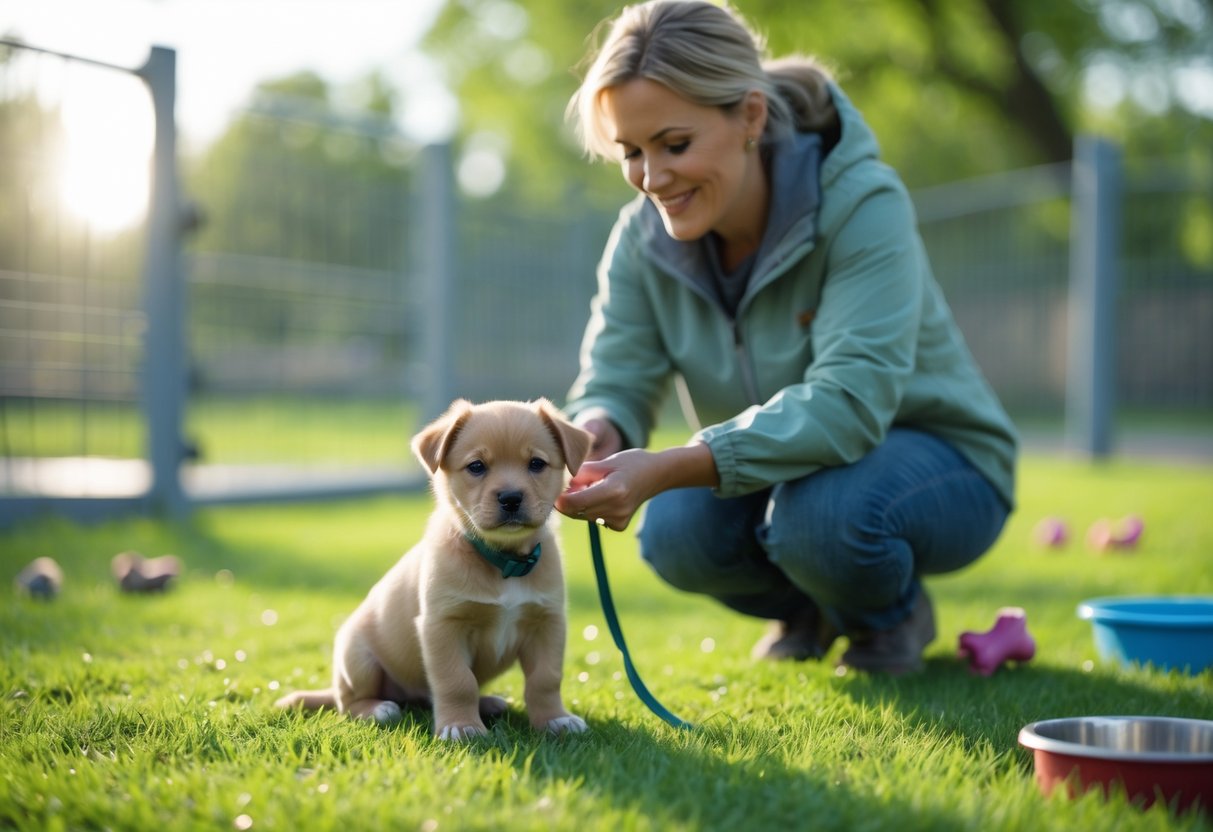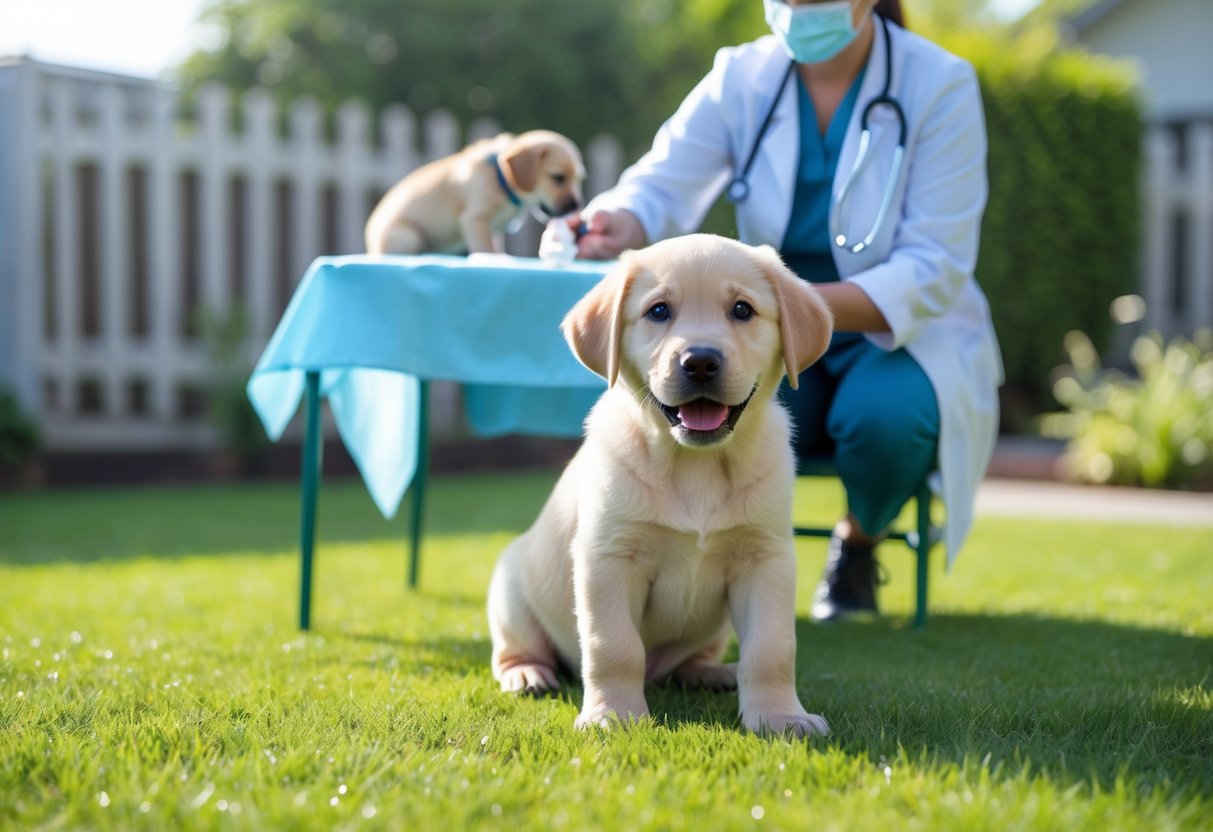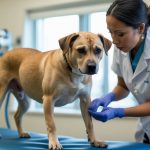Taking your new puppy outside is a huge milestone, and it’s honestly a little nerve-wracking if you’re not sure when it’s safe. Your puppy can usually go outside safely about two weeks after their second set of vaccinations, which is around 12 weeks old.
Before that point, you should keep outdoor time limited to private, controlled spots where the risk of disease is super low.
Even before they’re fully vaccinated, you can help your puppy see new things by carrying them to different places. That kind of early exposure is great for their social skills, and you don’t have to risk their health to do it.
Key Takeaways
- Puppies need to wait until after key vaccinations before going in public spaces.
- Private, safe outdoor areas offer good early experiences for your puppy.
- Controlled exposure helps with your puppy’s social skills and confidence.
Puppy Outdoor Safety Basics
Taking your puppy outside sounds simple, but it takes a bit of planning. You’ll need to watch them closely and make sure their play space is safe, especially if you’re using your own garden.
Knowing what dangers are out there and how to prepare will keep your puppy safer as they explore.
Risks of Early Outdoor Exposure
Puppies have weak immune systems until they finish their vaccinations. If you take them outside too soon, they can catch diseases like parvovirus, distemper, or kennel cough—none of which you want to deal with.
They’re also at risk from parasites like fleas, ticks, and worms that live in grass and soil. Chemicals such as pesticides or fertilisers can be toxic if your puppy licks or eats anything contaminated.
Stick to private spaces and avoid busy dog parks or areas where you don’t know the other dogs’ vaccination status.
The Importance of Supervision
Always keep an eye on your puppy outside. Puppies are curious and sometimes a little wild—they’ll try to eat anything, including toxic plants or random objects.
Supervision means you can stop them from chewing on something dangerous like chocolate, lilac, or foxglove. You’ll also be able to prevent falls, escapes, or getting stuck somewhere silly.
When you’re in public, a leash is a must. It gives you control while your puppy gets used to new sights and sounds.
Safe Garden Preparation
Before you let your puppy loose in the garden, do a quick safety check. Get rid of toxic plants, sharp tools, and any rubbish lying around.
Make sure your fence doesn’t have gaps where a tiny puppy could slip out. Keep the grass short and dry to help with ticks and other pests.
Don’t use chemicals on your lawn when your puppy is around. Check the ground for holes or wobbly spots, and always have clean water and a shady place ready.
If you want more advice on prepping for outside time, check out when can puppies safely go outside? vet-approved advice.
Understanding the Puppy Vaccination Schedule
Your puppy’s vaccination schedule is there to protect them from nasty diseases. It starts pretty early, and the timing matters for building up immunity.
Knowing which vaccines to get and when helps you keep your pup safe as they grow up.
Key Milestones in Puppy Vaccination
Vaccinations usually start when your puppy is about 6 to 8 weeks old. The first round covers core diseases like parvovirus and distemper.
Your puppy will need booster shots every 3 to 4 weeks after that first jab. This continues until they’re around 16 to 20 weeks old.
Between 12 and 15 weeks, most puppies get their rabies shot. In a lot of places, that’s the law. It takes about 28 days after the rabies shot for it to really kick in.
Your vet will walk you through the schedule and suggest any extra vaccines your puppy might need based on their lifestyle.
Core Vaccines: Parvovirus and Distemper
The big ones you need to worry about early are parvovirus and distemper. Both spread easily and can be deadly, especially for young puppies.
Parvovirus hits the digestive system hard—think vomiting and diarrhoea. Distemper goes after the lungs and nervous system, causing coughing and sometimes seizures.
Usually, these core vaccines get combined into one shot called DAPP (distemper, adenovirus, parainfluenza, and parvovirus). Puppies start this at 6 to 8 weeks and need several boosters for solid protection.
Vaccines and Immunity Timeline
After each shot, your puppy’s immune system needs a bit of time to build up. It usually takes about two weeks after the last booster for real protection to kick in.
So, your puppy is only fully protected from things like parvo and distemper about two weeks after their final vaccine—usually when they’re 18 to 22 weeks old.
During this window, keep your puppy away from public places where they could catch something. Your vet can give you the exact dates and advice for your area.
When Can Puppies Go Outside in Private Spaces?
You can start letting your puppy experience the outdoors at home before they’re fully vaccinated. This early exposure helps them get comfortable with the world, but you have to keep it safe and controlled.
First Outdoor Experiences at Home
Let your puppy have their first outdoor adventures in your garden, patio, or another private space once they’ve settled indoors. Keep these visits short and always supervise.
Carry your puppy or only let them touch the ground in spots you know are clean and haven’t been visited by other dogs. Their immune system is still getting stronger at this point, so be cautious.
Avoid areas where unvaccinated dogs might have been. A clean, enclosed spot in your garden is safest until your puppy finishes their shots.
Garden and Patio Guidelines
Check that your garden or patio is secure and free from hazards like sharp objects or poisonous plants. Let your puppy outside only on surfaces where your own vaccinated pets have safely played.
Don’t let them near places where other dogs might wander in. Puppies’ immune systems are fragile until about two weeks after their last vaccine.
Always supervise to stop your puppy from eating things they find outside, like rubbish or animal droppings. A playpen or fenced-off area works well to keep them safe while they explore.
Minimising Contact with Unvaccinated Animals
Keep your puppy away from unvaccinated dogs until their own vaccines are done. Carrying your puppy around different places can help with socialisation and doesn’t put them at risk.
Many diseases spread through direct contact or contaminated surfaces. Avoiding unvaccinated animals makes a big difference in keeping your puppy healthy.
If other dogs use your garden or shared spaces, clean those areas before letting your puppy out. It’s worth asking family or neighbours about their dogs’ vaccine status, just in case.
When Are Public Spaces Safe for Puppies?
Figuring out when it’s safe to take your puppy to public places is a big deal. It mostly comes down to where they are in their vaccination schedule and what your vet says.
Timing After Final Vaccinations
Your puppy isn’t really protected until about two weeks after their last core vaccine. These cover distemper, adenovirus, parainfluenza, and parvovirus (DHPP).
Most puppies finish this series between 16 and 20 weeks. After that two-week wait, you can start visiting parks or pet stores.
Rabies needs a bit longer—about 28 days after the shot. If you take your puppy out too early, they could catch something dangerous like parvo, which is tough to treat.
Areas to Avoid
Skip public spots where disease risk is high. Dog parks and busy paths often have dogs with unknown vaccination histories, and that’s risky for your puppy.
Stay away from places where sick dogs might have been, like vet waiting rooms or grooming salons. Even soil or grass with infected droppings can be a problem.
Stick to your own yard or friends’ yards with healthy, fully vaccinated dogs for early socialising. It’s just safer until your puppy’s immune system is ready for more.
Role of Veterinary Guidance
Your vet is your best resource for knowing when your puppy can explore public spots. They’ll set up a vaccine schedule that fits your puppy’s needs and local risks.
Vets might suggest extra vaccines, like leptospirosis or Bordetella, depending on your puppy’s lifestyle. Always check with your vet before trying new environments.
They can share tips for safe socialisation while your puppy’s immune system gets stronger. That way, you lower the risk of infection and can enjoy those first adventures together.
Socialisation Before Full Vaccination
You can start socialising your puppy safely before their vaccinations are complete, but you’ll need to take some precautions. Expose them to new sights, sounds, and gentle interactions, but keep illness risks in mind.
Early socialisation helps shape good behaviour and confidence during this tricky stage. It’s worth the effort, even if you feel a bit unsure at first.
Carrying Your Puppy Outdoors
Carry your puppy outside so they can experience outdoor sights, sounds, and smells safely. Hold them close or use a secure carrier when you stroll through quiet streets or parks.
This way, your puppy gets used to the world without touching risky surfaces or meeting unknown animals. Skip busy dog spots or places where unvaccinated dogs might hang out.
Start with short trips, then slowly make them longer. Keep it positive—treats and praise work wonders to build your puppy’s confidence.
This also lays the groundwork for leash walking and future adventures after vaccinations.
Safe Exposure to People and Animals
Let your puppy meet healthy, vaccinated dogs for early social skills. Set up playdates at home or in a clean, familiar yard with dogs you know are safe.
Avoid high-risk places like dog parks for now. It’s just not worth the gamble.
Invite different people—adults, kids, even strangers—for gentle, supervised interactions. Stick to indoors or controlled outdoor areas.
Watch your puppy’s comfort level and step in if things get overwhelming. You can also try puppy classes that require vaccination records.
These classes offer structured social time with dogs and people, plus some early training tips.
Early Socialisation Techniques
Let your puppy hear household sounds like vacuum cleaners, washing machines, or doorbells. Keep sessions short and upbeat, using treats and calm praise to keep them relaxed.
Introduce them to different surfaces—carpet, wood, grass, tile—to help with balance and confidence. Even short stroller rides or car trips in a carrier count as socialisation.
Practice gentle handling at home so your puppy gets used to touch. This builds trust and preps them for vet visits and grooming.
Want more details on safe puppy socialisation before vaccinations? Check out this puppy socialisation guide.
Toilet Training and Exercise in Early Weeks
It’s a balancing act—keeping your puppy safe while letting them get outside for bathroom breaks and some gentle exercise. Early toilet training sets good habits, and a bit of controlled exercise helps build confidence.
But you’ve got to watch out for diseases and hazards during these first weeks. It’s a lot to juggle, honestly.
Outdoor Toilet Training Safety
Only take your puppy outside for toileting once your vet says it’s okay—usually around 8 weeks old. Stick to clean, quiet spots and avoid places where unknown or unvaccinated dogs go.
Carry your puppy to the spot, so they don’t walk on risky ground. Praise and reward them right after they do their business.
Keep these trips short and calm. You want to avoid overstimulating your pup.
Always keep an eye out, especially if your puppy’s on a lead. Puppies will try to eat anything, so you have to stay sharp.
Indoor Exercise Alternatives
Skip long leash walks before full vaccination. Focus on indoor play to burn off energy.
Use soft toys, short games of fetch, or gentle tug toys. These keep your puppy active without putting them at risk.
Set up a safe play area inside for running and exploring. It helps with coordination and keeps boredom at bay.
Short, frequent play sessions work best—puppies tire out fast. It’s all about building up their mind and body bit by bit.
Garden Play Precautions
If you’ve got a private garden, make sure it’s totally secure and hazard-free before letting your puppy out. Only allow access if other dogs—especially unvaccinated ones—can’t get in.
Supervise your puppy every second outdoors. Puppies dig, chew, and try to escape if you blink.
Keep garden outings short and focused on getting comfortable, not wild play. Skip any chemicals or fertilisers in their play area.
Clean up waste quickly to keep things safe. Puppies learn fast, but you’ve got to help them along.
Need more info on safe outdoor time and toilet training? Here’s a handy guide on when puppies can go outside.
Frequently Asked Questions
Wondering when your puppy can safely explore outside? You’ll want to know which vaccinations matter most, how long to wait after the last shot, and what the risks really are. Plus, what’s the best way to introduce your puppy to the big, wide world? Supervision is everything those first few times out.
At what age is it safe for puppies to begin exploring outdoors?
Puppies can start going outside for short, controlled visits after their primary vaccination series. This usually happens between 12 and 16 weeks old.
Before that, it’s best to keep them indoors or in a secure yard. It’s just safer that way.
What vaccinations should be completed before puppies are allowed outside?
Your puppy needs core vaccines—distemper, parvovirus, and adenovirus. Most pups get these shots over their first 16 weeks.
Without them, your puppy’s at risk for some nasty diseases. It’s not something to mess with.
How long after the final vaccination can puppies go outside?
Wait about two weeks after the last vaccination for their immune system to catch up. After that, your puppy should be safe to visit public places and meet other dogs.
Are there risks associated with taking puppies outdoors too early?
Yes, there are real risks. Early outdoor trips can expose puppies to viruses, bacteria, and parasites.
Crowded or noisy spots can stress them out and slow their immune response. It’s better to be cautious.
What are the best practices for introducing puppies to outdoor environments?
Start in quiet, secure places like your own garden. Keep sessions short, then slowly make them longer.
Introduce new sights, sounds, and smells a little at a time, so your puppy doesn’t get overwhelmed. It’s a process, but it’s worth it.
How should I supervise my puppy’s first outdoor experiences to ensure safety?
Keep your puppy on a lead or inside a fenced area. That way, they can’t suddenly bolt or get into trouble.
Watch your puppy for any signs of tiredness or fear. If they seem nervous, it’s probably best to head back inside.
Try to avoid spots where unvaccinated dogs might’ve been. This helps lower the risk of your puppy picking up something nasty.
For more tips on when it’s safe for puppies to go outside, check out When Can Puppies Go Outside? from Purina.











